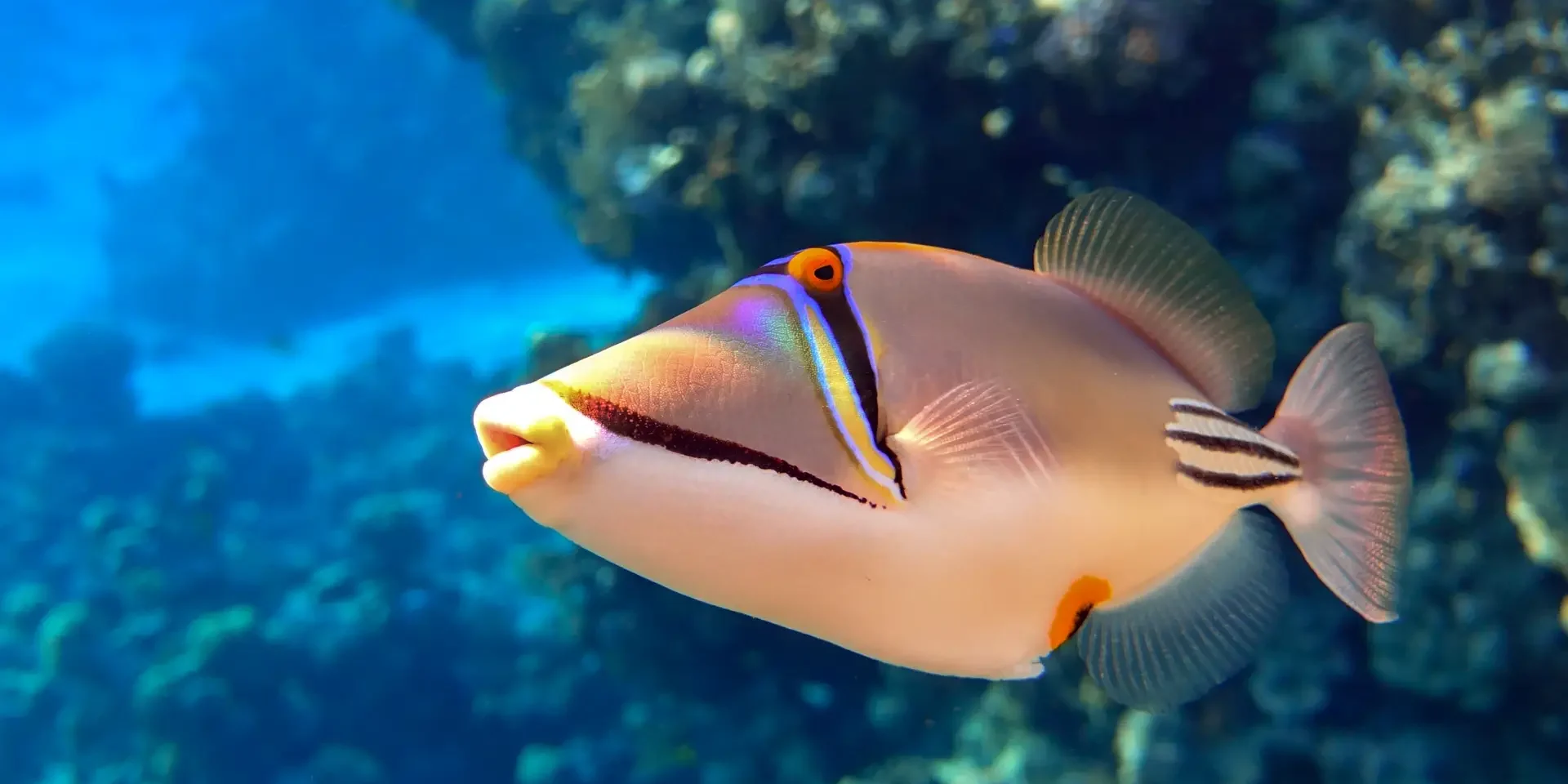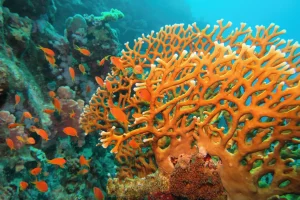Top 10 Must-See Marine Species in the Red Sea
The Red Sea is a diver’s paradise, renowned for its warm, crystal-clear waters, vibrant coral reefs, and extraordinary biodiversity. Stretching over 2,300 kilometers between northeastern Africa and the Arabian Peninsula, the Red Sea boasts an incredible array of marine life, including both endemic species and those found throughout the Indo-Pacific. For divers of all levels, spotting some of the Red Sea’s most iconic and fascinating marine creatures is a bucket-list experience.
In this guide, we highlight the top 10 must-see marine species in the Red Sea, from tiny critters hiding in crevices to majestic predators patrolling the reefs. Whether you’re a recreational diver or a passionate underwater photographer, these species will make your dives unforgettable.
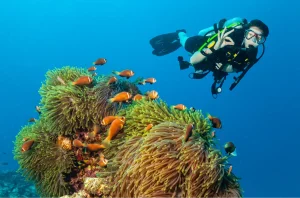 1. Clownfish (Amphiprion spp.)
1. Clownfish (Amphiprion spp.)
Where to see them: Shallow reefs and anemone-rich areas
Why they’re a must-see:
Clownfish, often called “Nemo” fish thanks to popular culture, are a highlight of any Red Sea dive. They live in symbiosis with sea anemones, receiving protection from predators while helping keep the anemone clean. The Red Sea is home to several species of clownfish, including the endemic Red Sea clownfish, which can be distinguished by its striking orange and black coloration. Watching these small, colorful fish dart among the anemone’s tentacles is a delight for divers and photographers alike.
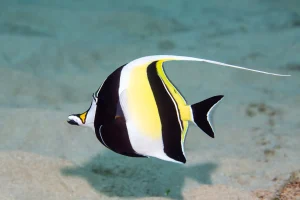 2. Moorish Idol (Zanclus cornutus)
2. Moorish Idol (Zanclus cornutus)
Where to see them: Coral slopes and reef edges
Why they’re a must-see:
The Moorish idol is instantly recognizable by its long, trailing dorsal fin and bold black, white, and yellow stripes. Although sometimes challenging to photograph due to its constant movement, seeing this elegant fish swimming gracefully along a coral reef is a memorable experience. Moorish idols are often found in pairs or small groups, adding to the beauty of the reef scene.
3. Hawksbill Sea Turtle (Eretmochelys imbricata)
Where to see them: Coral reefs, seagrass beds, and wrecks
Why they’re a must-see:
Hawksbill turtles are critically endangered, making sightings in the Red Sea both special and significant. Known for their stunning, patterned shells and delicate beaks, hawksbills feed mainly on sponges, helping maintain healthy reef ecosystems. Divers often spot these turtles gliding gracefully over the reef or resting in crevices, providing countless photo opportunities.
4. Lionfish (Pterois miles)
Where to see them: Coral reefs, wrecks, and drop-offs
Why they’re a must-see:
Lionfish are venomous yet mesmerizing, with flowing fins and bold red-and-white stripes. Native to the Indo-Pacific, including the Red Sea, lionfish are predators that feed on smaller reef fish. Despite their beauty, they are a reminder of nature’s balance and the delicate food webs in coral reef ecosystems. Observing a lionfish hover in its territory is a captivating sight for any diver.
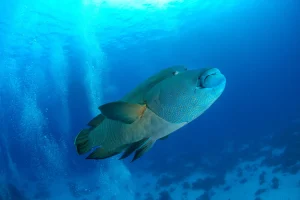 5. Napoleon Wrasse (Cheilinus undulatus)
5. Napoleon Wrasse (Cheilinus undulatus)
Where to see them: Deep reef slopes and cleaning stations
Why they’re a must-see:
The Napoleon wrasse, also known as the humphead wrasse, is one of the largest reef fish in the world. Its prominent forehead hump, striking blue-green coloration, and curious behavior make it a standout sight for divers. These fish are known to interact with cleaner fish, and spotting one while diving is a rare and impressive experience. Unfortunately, they are endangered due to overfishing, so seeing them is truly special.
6. Octopus (Octopus vulgaris and others)
Where to see them: Reef crevices, sandy bottoms, and rocky outcrops
Why they’re a must-see:
Octopuses are masters of camouflage and intelligence. The Red Sea is home to a variety of octopus species that can change color, texture, and shape to blend seamlessly into their surroundings. Divers often catch brief glimpses of these fascinating cephalopods as they hide in crevices or move slowly along the reef, offering an exciting and sometimes challenging photo opportunity.
 7. Angelfish (Pomacanthidae family)
7. Angelfish (Pomacanthidae family)
Where to see them: Coral reefs, lagoons, and drop-offs
Why they’re a must-see:
Angelfish are known for their vibrant colors, patterns, and graceful swimming. Species like the Emperor angelfish and Blue-girdled angelfish are common in the Red Sea. Their bold markings and tendency to hover around coral heads make them a favorite among underwater photographers and divers seeking striking reef visuals.
8. Moray Eels (Muraenidae family)
Where to see them: Reef crevices, caves, and wrecks
Why they’re a must-see:
Moray eels are both mysterious and intimidating, often peeking out from rocky holes with a watchful eye. Common Red Sea species include the Giant moray and the Snowflake moray. While they may appear aggressive, moray eels are generally shy and will retreat into their hiding spots if approached. Observing one extend from a coral cavity to hunt is a thrilling experience for divers.
9. Anthias (Pseudanthias spp.)
Where to see them: Reef slopes and coral walls
Why they’re a must-see:
Anthias are small, colorful schooling fish that bring life to the Red Sea’s reefs. They are often seen in large groups, darting in synchronized movements around coral heads. Their bright pink, orange, and purple hues create vibrant underwater scenes that are mesmerizing to watch and photograph. Anthias are active during the day, making them a constant source of motion and color on any dive.
10. Barracuda (Sphyraena spp.)
Where to see them: Open reef areas, drop-offs, and wrecks
Why they’re a must-see:
Barracudas are fast, sleek predators that often patrol the reef edges in search of prey. The Red Sea’s silver barracudas are particularly striking as they glide in small groups, reflecting sunlight and creating dramatic underwater visuals. Their presence adds excitement to dives, especially when observed in action as they hunt smaller fish or swirl around reef structures.
Tips for Spotting Red Sea Marine Life
-
Dive Early or Late: Many species are more active during early morning or late afternoon dives.
-
Slow and Steady: Move gently to avoid spooking shy creatures like octopuses or moray eels.
-
Use a Dive Guide: Local dive guides know the best spots for encounters with elusive species like hawksbill turtles and Napoleon wrasses.
-
Bring a Camera: Many of the species in the Red Sea are photogenic and perfect for underwater photography.
-
Respect Wildlife: Maintain a safe distance, avoid touching, and never chase or harass marine life. Conservation is key to protecting these species for future divers.
Conclusion
The Red Sea is a treasure trove of marine biodiversity, offering divers the chance to see a wide variety of fascinating species. From the playful clownfish and majestic hawksbill turtles to the elusive moray eels and sleek barracudas, each dive promises a unique experience. By respecting the underwater environment and observing marine life responsibly, divers can enjoy the beauty of the Red Sea while helping preserve its incredible ecosystems.
Whether you’re a beginner or an experienced diver, these top 10 must-see marine species should be on your Red Sea diving bucket list. Every dive offers a new opportunity to witness the wonders of this underwater paradise.


